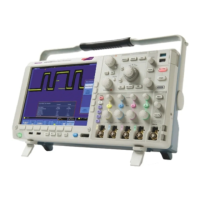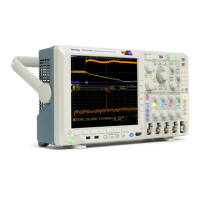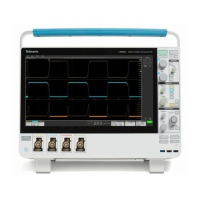Performance Verification
Table 12: Maximum Bandwidth Frequency worksheet (cont.)
Model: DPO4054, MSO4054
1MΩ 2 mV/div
300 MHz
1MΩ 1 mV/div
175 MHz
Model: DPO4034, DPO4032, MSO4034, MSO4032
50 Ω 5 mV/div
350 MHz
50 Ω 2 mV/div
350 MHz
50 Ω 1 mV/div
200 MHz
1MΩ 5 mV/div
350 MHz
1MΩ 2 mV/div
300 MHz
1MΩ 1 mV/div
175 MHz
1
For DPO4104, MSO4104, DPO4054, and MSO4054 bandwidth verification, use 380 MHz, rather than 500 MHz,
on the 5 mV/div vertical scale due to an impedance mismatch between the calibrator and the oscilloscope.
When the calibrator is set to 1 MΩ load, it has a Thevenin equivalent 25 Ω source impedance. Passing the test
with a 380 MHz signal verifies 500 MHz performance with a P6139A probe on models DPO4104, MSO4104,
DPO405
4, and MSO4054.
16. Use the values of V
bw-pp
and V
in-pp
obtained above and stored in the test record
to cal
culate the Gain at bandwidth with the following equation:
Gain = V
bw-pp
/ V
in-pp
To pass the performance measurement test, Gain should be ≥ 0.707. Enter
Gain in the test record.
17. Repeat steps 9 through 16 for the other oscilloscope volts/div settings listed
in the test record.
18. Set the calibrator to 1 MΩ output impedance to generate a sine wave.
19. Push the channel button (1,2,3,4) for the same channel that you used in step 3.
20. Change the oscilloscope impedance to 1 MΩ.PushtheImpedance
lower-bezel button to select 1 M Ω.
21. Repeat steps 9 through 17.
22. Repeat steps 3 through 21 for each channel combination listed in the test
record and relevant to your model of oscilloscope (for example, 1,2,3,4).
40 MSO4000 and DPO4000 Series Specifications and Performance Verification

